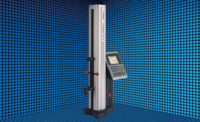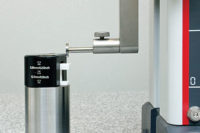The height gage has transformed. From its infancy to today, the height gage has been in the grittiest shop environments. In spite of that, height gages also have the ability to meet the quality measurement demands of any precision laboratory. Regardless of how they are used or where, height gages have stood the test of time and remain an essential tool in every workshop.
When Pierre Vernier invented the Vernier scale (1631) for use with a “Vernier” caliper, the metrology world was transformed. With the use of these dissimilar scales, mechanical engineers and quality engineers alike were able to produce components with far greater precision than ever before. Vernier scales were soon adapted for use with some of the first height gages. When you come right down to it, the earliest height gages were Vernier calipers standing upright on a solid base. Inspectors and machinists soon found other ways to use height gages, such as scribing. Early height gage designs gave inspectors the ability to measure a wide assortment of dimensions with greater speed and better accuracy. This was just the beginning of a rapid evolution for the height gage.
In the decades to follow, the height gage gained popularity and supported the work of inspectors and machinists around the world. The challenge of improving the instrument was taken on by many. From the earliest Vernier gages came the single and twin beam Vernier height gages. Next came the introduction of the transfer gage. The transfer gage, most commonly known as a Cadillac gage, was a way to use the height gage more precisely. The Cadillac gage is a height stand that has several known heights (or steps) which will allow an operator to use a height gage with a mounted test indicator to measure the deviation from whatever known surface is appropriate on the Cadillac gage. For example, if an operator needs to measure a part that is close to 1.000˝, they will zero (0.000˝) the test indicator on the 1˝ land on the Cadillac gage, then measure the deviation from zero on their part. If the indicator reads 0.005” in the positive (clockwise) direction, the part is 1.005˝, and if the test indicator reads 0.005˝ in the negative (counter clockwise) direction, the part is 0.995˝. With a Cadillac gage and a good test indicator, inspectors were able to achieve very accurate and repeatable results.
While the height gage and transfer stand became an essential part of every inspection department, skilled machinists were always looking for opportunities to be more efficient. In most machine shops, the machinist was responsible for volume production while also inspecting the parts they produced. With a greater need for reduced inspection time came another evolution, the electronic height gage. The electronic height gage was the instrument that combined the height gage and transfer stand using new increased technology in the electronic displays (similar to a small computer screen) and the ability to utilize high accuracy scales.
Reducing inspection times while maintaining accuracy and repeatability has always been a challenging task. With the newest electronic height gages, inspectors and machinists are now able to take on difficult and time-consuming measurements with great ease and accuracy.
The initial advancement of the electronic height gages was the ability to eliminate the need for calculations on both part sizes and probe tip diameters. The new electronic height gages are capable of learning the probe diameter size through a simple calibration procedure. From this point forward, an operator can measure many characteristics of a component and the height gage will understand not only the probe tip diameter size, but also in which direction (up or down) the part is being measured. This calibration procedure eliminates the need to add probe diameters to a measured value, such as with the height stand and Cadillac gage.
The continuous evolution of the height gage has brought us to the point we are at today. In the current market, you can find 1D, and even 2D height gages that have increased functionality. It’s impressive that height gages can work right on the shop floor, part of a machining cell, and yet perform many of the same measurements of a CMM. Today’s height gages are far more capable than the Vernier height gage of the past. They can measure: IDs, ODs, center-lines, heights, widths, depths, slots, groove diameters, groove widths, max points, min points, TIR, angles, perpendicularity, bolt hole diameters, angles between holes, distances from two holes…and plenty more! They can be programmed to play back a sequence of measurements, and even export data to a computer. Height gages can also support varying measuring ranges and degrees of accuracy. The common electronic height gages will measure a 28˝ range accurate to 0.0001˝ to 0.0002.˝ However, if the need is there, height gages are available to measure upwards to 80˝ high and can maintain an accuracy better than 0.00005˝.
Metrology is experiencing dramatic improvements. Electronics, microprocessors, new software and now Bluetooth communications continue to transform the very concept of the height gage. Today’s height gage continues to be a robust tool, made for harsh shop environments. Now with dramatically increased functionality, increased accuracy and solid repeatability, a height gage is a great solution and quickly cost justified, at any manufacturing facility. The height gage is still one of the best, most versatile inspection instruments an owner, machinist or inspector could ever ask for.



